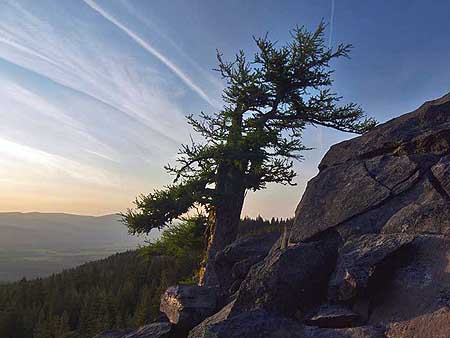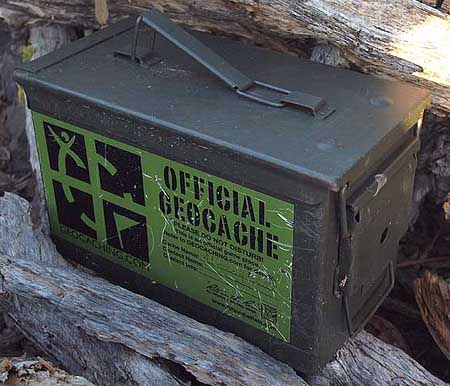
You won’t find Tamarack Rock on any maps, though this rugged knoll is hidden in plain sight — just off the Surveyors Ridge Road (FR 17) on the east side of Mount Hood. The rock didn’t get much respect during the logging heyday of the late 1900s, with gravel spur roads wrapping almost entirely around the rock, and big ponderosa trees felled from its gentle southern flank.
But through all the destruction that reigned here, a lone Western larch tree survived in a most unlikely spot, among the huge boulders near the crest. The tree is among the most magnificent of its kind in the area, a massive, gnarled, determined old sentinel that has managed to dodge lightning strikes and fires, as well as chainsaws.

Mount Hood at dusk from Tamarack Rock
The view from the rock is glorious, with the broad northeastern face of Mount Hood towering over waves of forest ridges, and the tiny farms and orchards of the Upper Hood River Valley, spread far below. The forested Mill Creek Buttes complete the scene, to the east. The scenery is so sweeping that it’s easy to forget the maze of logging roads and clearcuts all around. In this way, Tamarack Rock survives, surprisingly intact.

A birds-eye view of Tamarack Rock
I had passed the rock countless times over the years, always promising myself that I’d explore this postage-stamp wilderness someday. This spring, I finally made good on the promise, and explored the landmark from all sides. Trail riders and hikers are already familiar with the rugged west face of the rock, where it towers above the popular Surveyors Ridge Trail. From this angle, the rock has a “face”, which in turn led to a spirited discussion among the PortlandHikers.org community on just what to call the rock — if it didn’t already have a name.

A quick survey of those familiar with the area didn’t reveal a local name for the rock, so I posted a survey on PortlandHikers.org to poll a few options. When the votes were counted, the uncanny resemblance of the “face” to a certain Hollywood film director won the day, and it appeared that this landmark might become “Hitchcock Rock” to recreationists. Fortunately, the story didn’t end there, though it led to some creative photo interpretations (see below).

This is where the PortlandHikers.org discussion sent me back to the rock, because it was unclear from my early photos whether the ancient tree near the crest was living, dying or dead — or simply a larch in dormant winter phase, sans needles. My second visit a few weeks later revealed a fresh burst of new needles covering the old giant, and redirected the naming discussion to the tree in question.
Given the proximity of Larch Mountain (and other features) using the larch as namesake, the PortlandHikers.org consensus was to fudge a bit by using the “tamarack” name, instead. This is botanically incorrect, but as we learned in our debate on the subject, a good portion of the west actually uses the name “tamarack” to describe Western larch, and it had a nice ring to it, besides: Tamarack Rock!

I wasn't the first to the top, and surely won't be the last..!
On this follow-up visit to the rock, I also discovered a long history of visitors, beginning with a geocache box tucked into an inconspicuous hiding spot. The journal inside listed a visitor earlier the same day, remarking on a “large coyote” seen near the rock. Other visitors simply commented on the impressive views.
Not far from the geochache were a couple of homemade memorials, honoring Adam J. Dietz Sr. (1917-1997) and Alfred West (1910-1998). Clearly, these two gentlemen had some connection with the rock, but for now, I can only assume they worked or hunted in the forest, and might have been local to the area. But their presence further cemented the idea of a more respectful name for the rock, no matter the Hitchcockian resemblance.

The rustic Adam J. Dietz Sr. Memorial on Tamarack Rock
Yet the human history of Tamarack Rock seems to go back even further, and perhaps by millennia: a few yards from the aluminum Alfred West memorial cross, there are at least two, and possibly three Native American ceremonial pits. One is quite obvious, a second somewhat compromised and a third barely visible. The pits are located in full view of the mountain, and mimic similar pits in the area, including this subject of an earlier post.
Finding all this human history in gathering twilight on that brisk spring evening was exhilarating, to say the least. It was yet another reminder that we are all just passing through, and how we treat this land will be our only real legacy. Tamarack Rock has clearly been admired and loved for generations, and how fortunate we are that the even the era of road building and forest destruction didn’t destroy this unique place.
In another century, there’s a good chance the old larch tree will still live, clinging to this rock, long after we’re gone. If the old tree does survive, it will be a pretty good measure of our collective will to leave the Mount Hood country in better shape than we found it. It will also reflect our human capacity to honor places like this simply because of their spiritual significance to those who came before us.
I think we’re up to that challenge.